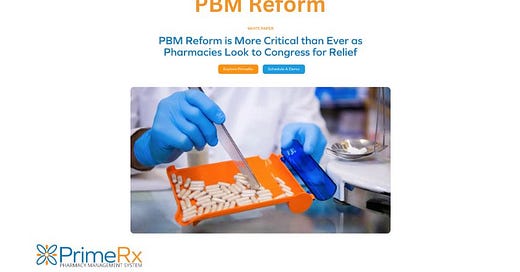PrimeRx Releases In-Depth White Paper on the Critical Need for PBM Reform and Technology Solutions for Pharmacies
White Paper | Learn how pharmacy benefit managers (PBMs) are impacting community pharmacies and how technology like PrimeRx can help mitigate these challenges. | Sponsored
PrimeRx has released a new white paper, available on the PrimeRx Blog, that dives deep into the pressing issues surrounding pharmacy benefit managers (PBMs) and their significant impact on community pharmacies.
It highlights the challenges pharmacies face due to PBM practices, including underpayments, steering of patients to PBM-owned pharmacies, and a lack of transparency. The paper also discusses the near success of legislative reform in 2024 and emphasizes the crucial role that technology, specifically solutions like PrimeRx, can play in helping pharmacies navigate this complex landscape and improve their operational efficiency and financial health.
The Case for PBM Reform in 2025
PBMs are facing increasing scrutiny and calls for reform due to their significant negative impact on community pharmacies. Despite spending $17 million in 2024 to block meaningful legislative reform, PBM practices remain a critical issue for pharmacists nationwide.
The white paper reveals several key ways PBMs negatively affect pharmacies:
Underpayment for prescription drugs: A New York Times expose in 2024 found that PBMs systematically underpay small pharmacies, contributing to hundreds of closures. Pharmacies have reported reimbursements for certain medications being lower than their purchase costs.
Mandatory use of PBM-owned pharmacies: PBMs employ tactics to steer patients towards their own pharmacies, limiting patient choice and harming independent pharmacies. This includes preventing 90-day prescriptions at competing pharmacies or offering better pricing only through PBM-owned pharmacies.
Excessive fees and lack of transparency: PBMs impose various fees and operate with little transparency regarding rebates received from drug manufacturers, often not passing these savings on to health plans or patients.
Spread pricing: PBMs sometimes pay pharmacies less than they charge health plans for the same prescription, pocketing the difference.
The white paper points out that meaningful PBM reform nearly passed in Congress in 2024 but was ultimately stripped out at the last minute. These reforms included basing reimbursements on the National Average Drug Acquisition Code (NADAC), requiring the Centers for Medicare & Medicaid Services to develop reasonable contract terms, and eliminating spread pricing. Despite this setback, efforts for reform continue at both the federal and state levels.
Click through to read the complete white paper as it makes the case for PBM reform.
How Technology can Help Mitigate PBM Fallout for Community Pharmacy
In the absence of comprehensive reform, the white paper emphasizes the crucial role of technology in helping pharmacies navigate the challenges posed by PBMs.
Among the key features within the PrimeRx suite of technology that offer solutions are:
Improve reimbursement management: PrimeRx helps pharmacists understand their plan contracts and anticipate reimbursements, providing better financial planning.
Optimize drug purchasing: PrimeRx MARKET allows pharmacies to compare prices from multiple wholesalers, ensuring cost efficiency.
Expand revenue opportunities: Technology can support the addition of clinical services, OTC sales, and better patient engagement.
Enhance operational efficiency: Automation of workflows, inventory management, and claims processing saves time and reduces costs.
PrimeRx concludes the white paper by underscoring the dire situation faced by many community pharmacies due to PBM practices, with some being forced to close.
However, it offers a message of hope by highlighting how technology like PrimeRx can provide valuable tools to mitigate the impact and help pharmacies remain viable while the fight for PBM reform continues.
This white paper provides a crucial understanding of the challenges facing local pharmacies due to PBM practices and how technology can offer a path forward. Read the full paper for a more in-depth look at this critical issue.
Sponsored




